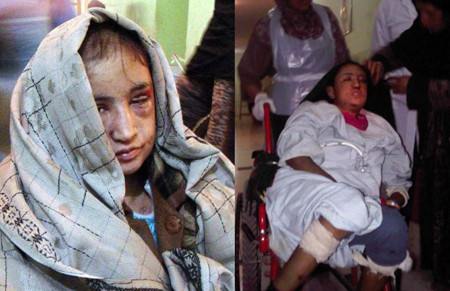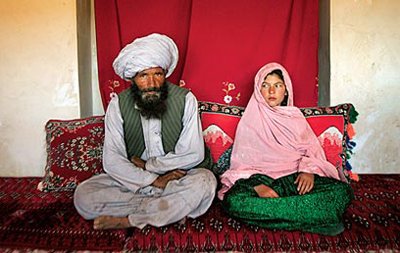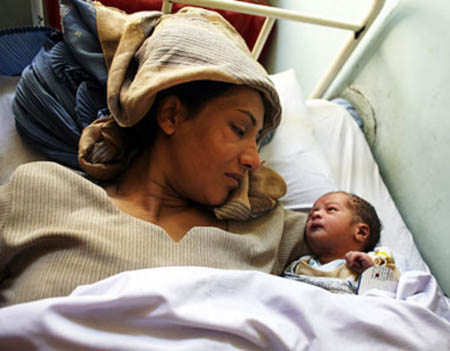By Dana Visalli
“When I was young I had not courage, but now I have courage.” Asra, a 12 year-old Afghan girl who lived in a refugee camp in Pakistan until she was 9
Afghanistan has been called ‘the worst place in the world to be a woman,’(1) because not only is the poverty pervasive and the lifespan short, but while they are alive many women live like serfs. Afghan students at the private school for girls where I work in Kabul recently produced a series of essays in which they describe the social norms for women in their country. One wrote, ‘A girl in my culture marries at eleven or twelve years of age. Some parents make their daughters marry when they are very young so they can get money for their daughter and the family can be rich. When a girl is married, she accepts her husband’s orders; she must never tell people if she is being treated badly.’ Another of the girls was more blunt: ‘When sisters sit together, they always praise their brothers; when brothers sit together, they sell their sisters to others.’(2)
Human Rights Watch said in a recent report that the situation for women in Afghanistan is ‘dismal in every area,’ with violence against them ‘endemic’ and a government that fails to protect them from crimes such as rape and murder.(3) The report cites cases where rapists have been pardoned by the government, girls and women have been imprisoned for running away from home, rape victims have been charged with adultery and where women in public life have been murdered. Afghan women’s rights activist Malalai Joya writes that, ‘The U. S. presence in Afghanistan is doing nothing to protect Afghan women. The level of self-immolation among women was never as high as it is now. There is no justice for women.’(4) She contends that the overall situation for women has in some ways gotten worse during the 13 year U.S. occupation because the U.S. financed the Islamic fundamentalist mujahideen during the war with the Russians and allowed them to control the Afghan government after the fall of the Taliban. Phumzile Mlambo-Ngcuka, the executive director of UN Women, says attacks against women and girls have increased at a frightening pace. In 2012, female casualties increased by 20 percent over the previous year, and then by 61 percent in 2013.(5)

Sahar Gul, a 15-year old girl brutally tortured by her in-laws for refusing prostitution. (Photo: RFE/RL)
As disturbing as this news is, the oppression of and violence towards women in Afghanistan is in no way unique. While researching their book Half the Sky:Turning Oppression into Opportunity for Women Worldwide, Nicholas Kristoff and Sheryl WuDunn discovered what they called a ‘pandemic’ of abuse of females by men around the world. To begin with, in China, India and elsewhere female fetuses are regularly aborted in favor of male babies; demographers say that more than 100 million females are ‘missing’ from the world due to what they call ‘gendercide.’ Once born, the British medical journal The Lancelet estimates that among the very poor of the world 1 million children are forced into prostitution every year, and the total number of prostituted children could be as high as 10 million. 130 million women alive today have endured genital mutilation, the cutting out of portions of their reproductive system, in order to destroy any sexuality.(6)
The United States is certainly not immune to gender abuse; one study found that over 22 million women in the United States have been raped in their lifetime. Every two minutes someone is sexually assaulted in the United States, and somewhere in America a woman is battered, usually by her intimate partner, every 15 seconds. An estimated 17,500 women and children are trafficked into the United States annually for sexual exploitation or forced labor.(7)
The most relevant question that can be asked is, ‘Why is this happening?’ From a historical perspective this perverse dynamic beween the sexes has distant roots. In Ancient Greece, Athenian women were given no education and were married at puberty to grown men. They remained forever the property of their fathers, who could divorce them and make them marry another. They lived in segregation and could not leave the house without a chaperone. They could not buy or sell land. If one were raped her husband had either to divorce her or lose his citizenship.(8)
The Bible and the Koran both reflect the mores at the time of their writing, and perpetuate male dominance into the present through their social paradigms. In the Old Testament, Genesis 3:16 instructs women that, ‘Thy desire shall be to thy husband, and he shall rule over thee,’ and Ephesians 5:22 commands, ‘Wives, be subject to your husbands as you are to the Lord.’ Such teachings prompted 19th-century feminist Elizabeth Cady Stanton to write: ‘The Bible and the Church have been the greatest stumbling blocks in the way of woman’s emancipation.’(9)
...
Phumzile Mlambo-Ngcuka, the executive director of UN Women, says attacks against women and girls have increased at a frightening pace. In 2012, female casualties increased by 20 percent over the previous year, and then by 61 percent in 2013.
Similar passages are found in the Koran, such as 4:34: ‘Men have authority over women because God has made the one superior to the other. Good women are obedient. As for those from whom you fear disobedience, admonish them and forsake them in beds apart, and beat them.’(10)
The Catholic Pope Innocent issued a Papal Bull in 1484 on the problem of demons in which he initiated the systematic accusation, torture and execution of countless ‘witches’ all over Europe, all of the females. Innocent commissioned a document called Hammer of Witches which basically said that if you were accused of witchcraft, you were a witch. Torture was an unfailing means to demonstrate the validity of the accusation. The most fantastic testimony was readily accepted—that tens of thousands of witches had gathered for a Sabbath in public squares in France, or that 12,000 of them darkened the skies as they flew to Newfoundland. The Bible had counseled, ‘Thou shalt not suffer a witch to live’; so legions of women were burned to death.(11)
There were strong erotic and misogynistic elements, as might be expected in a sexually repressed, male-dominated society with inquisitors drawn from the class of nominally celibate priests. The trials paid close attention to the quality and quantity of orgasm in the supposed copulations of defendants with demons or the Devil. No one knows how many women were killed altogether—perhaps hundreds of thousands, perhaps millions.(12)
A best-selling book titled Advice to a Daughter published in London in the early 1700s, and widely read in the American colonies, gives the flavor of a woman’s station in that time. ‘There is Inequality in Sexes, and that for the better Economy of the World; the Men, who were to be the Law-givers, had the larger share of Reason bestow’d upon them; by which means your Sex is the better prepar’d for the Compliance that is necessary for the performance of those Dudes which seem’d to be most properly assign’d to it.’(13)
On one level we can attribute the abuse of women to a long tradition of males viewing females as weaker and inferior members of the human family. There are deeper psychological currents as well. Since the advent of large urban and agricultural civilizations, humans have demonstrated an extreme antipathy for the natural cycles of life on earth. Not only do rivers flood and rains fail, threatening society, but death itself menaces each individual. The rich and powerful could attempt to escape death by building religious monuments that rose away from the earth to reach the sky—ziggarats and pyramids—but their efficacy against the inevitability of death was minimal.

This sobering image, showing a 40-year-old groom sitting beside his 11-year-old future bride in Afghanistan, brought Stephanie Sinclair top honors in the annual Photo of the Year contest sponsored by the United Nations Children's Fund (UNICEF).
Women on the other hand are wedded to the earth’s cycles, and are therefore problematic because they are evidently more earth-bound by nature. Not only can they create new life inside their bodies, which no male is capable of, but they also exude body fluids back to the earth monthly (menstruate) and they produce milk to nurture life. Male discomfort with this arrangement is illustrated in the Bible, where it is written, ‘If a woman has born a man child, then she shall be unclean seven days. But if she bear a maid child, then she shall be unclean two weeks.’ (Leviticus 12:5). The Koran offers supporting arguments: ‘Keep aloof from women during their menstrual periods and do not approach them until they are clean again.’ (2:222) The message is that when women menstruate they are earthy, dirty, untouchable. Many of those burned at the stake in the Middle Ages as witches were midwives and herbalists—women who were knowledgable about nature. And some of them had orgasms; a sure sign of devil-worship.
In our time males are still engaged in a war against the Earth and against the painful reality of death. While we do not think of it as such, modern warfare has in fact become a war against the Earth itself. Ecologist Wendell Barry writes, ‘We’re living, it seems, in the culmination of a long warfare—warfare against human beings, other creatures and the Earth itself.’ In steadfast pursuit of this war, the United States has dropped 20 million tons of high explosives on the Earth in the last 70 years along with a million tons of napalm and 22 million gallons of toxic herbicides in an effort to eradicate imaginary evil (usually in the form of impoverished rice farmers in Asia) and thus gain a sense of heroic purpose. And, killing others offers a brief feeling of immortality. The profound sham and transience of the experience of war and killing others is a major reason that currently 22 war veterans commit suicide every day; they can no longer live the lie that they were enticed into.(14)
A 2002 report titled ‘War on the Earth’ details how nearly thirty years after the end of the U.S. war in Southeast Asia, many of the affected ecosystems have still not recovered, according to the Environmental Conference on Cambodia, Laos and Vietnam. Ten percent of southern Vietnam’s forests (including one third of the coastal mangroves, which play a vital role in the coastal ecosystem and fish habitats) were destroyed by the 20 million gallons of herbicide the U.S. military dropped during the Vietnam War era. Arsenic and dioxin in the herbicides are expected to pose a health threat long into the future. Since 1975, 50,000 civilians have been killed by the landmines and other weapons the U.S. military left behind. The U.S.’s vast bombing campaign also left millions of large bomb craters. This war in Southeast Asia is is just one of innumerable examples of the American the assault on the Earth.(15)

Mother with her newborn baby in Afghanistan. (Photo: http://sbfphc.wordpress.com/2013/03/13/making-misoprostol-widely-available-for-home-births-in-afghanistan-new-policy-initiative/)
In addition, the United States maintains by far the most potent arsenal of nuclear weapons on the planet, which if used would destroy most of the biosphere and signal a final victory for man over his apparent arch enemy, the Earth which gives him life.
In the insightful book The Denial of Death author Ernest Becker observes that the terror of death is so overwhelming we do everything in our power to remain unconscious of it. We are defended by a fortress of self-identity that feels immortal, even though it is not, and a social hero system that allows us to believe that we transcend death by participating in something larger than ourselves. The root of human evil according to Becker is our need to deny our mortality by gaining a sense of permanent selfhood.
Another facet of this assault on women and the biosphere is the human proclivity to seek an external authority to tell us who we are and how to act. Not only are we faced with the humiliation and horror of death, but we are confused as to our purpose while alive. ‘We are,’ wrote cosmologist Carl Sagan, ‘like a newborn baby left on a doorstep, with no note explaining who it is, where it came from.’ So we turn en masse to individuals who purport to have answers. ‘Why in the world,’ asked French philosopher Etienne De La Boetie, ‘do people consent to their own enslavement? The mystery of civil obedience: why do people, in all times and places, obey the commands of government, which always constitutes a small minority of the society? If we led our lives according to the ways intended by nature and the lessons taught by her, we should be intuitively obedient to our parents; later we should adopt reason as our guide and become slaves to nobody.’ De la Boetie penned these lines in the year 1552 in his treatise, The Politics of Obedience.
There is an alternative to the mass destruction of ecosystems and of half the human race, and that is for every adult human being to reject external authority and take responsibility for their own lives. After all, as John Lennon pointed out, ‘Our society is run by insane people for insane objectives. We’re being run by maniacs for maniacal ends.’ People in the United Sates seem to fear their government as if it were some kind of god, even though the American government is ‘the greatest purveyor of violence in the world today,’ according to Martin Luther King, and it is clearly the greatest source of human suffering and death and of ecosystem destruction on the planet. If you as a unique, sovereign living being of the Earth do not want to see the biosphere destroyed by nuclear weapons, why have you spent your life paying for them? The answer can only be fear; your fear of your so-called government has to date overwhelmed your desire to live a sane and ethical life.
Ernest Becker writes in The Denial of Death, ‘There are signs that some individuals are awakening from the long, dark night of tribalism and nationalism and developing a moral conscience, an ethic that is universal rather than ethnic. Our task for the future is exploring what it means for each individual to be a member of earth’s household, a commonwealth of kindred beings. Whether we will use our freedom to encapsulate ourselves in narrow, tribal paranoid personalities and create more bloody Utopias or to form compassionate communities is still to be decided.’
It is a simple task to see in retrospect the journey that humanity has been on, with personal identity and consciousness transitioning from the family to the clan, and through tribe, village, and city-state to the nation-state. It is up to every individual who cares about the Earth and the creatures upon it to continue the journey and become a life-enhancing member of the Earth household.
Dana Visalli is an ecologist and organic farmer living in Washington state, email is dana@methownet.com
An illustrated version of this essay is available at http://www.methownaturalist.com/21-Afghanistan%202014.pdf
Footnotes:
1. Reuters Foundation: Afghanistan worst place in world to be a woman: http://www.theguardian.com/world/2011/jun/15/worst-place-women-afghanistan-india
UNICEF: Afghanistan worst place in the world to be pregnant: www.unicef.org/newsline/02pr59afghanmm.htm
Save the Children: Afghanistan the worst place in the world to be a mother or child: http://www.ips.org/mdg3/afghanistan-the-worst-place-to-be-a-mother-or-a-child/
2. Testimonials available at http://tinyurl.com/nr62scq
3. http://news.yahoo.com/s/nm/20091206/wl_nm/us_afghanistan_women
4. http://www.alternet.org/reproductivejustice/141165/why_is_a_leading_feminist_organization _lending_its_name_to_support_escalation_in_afghanistan/?page=entire
5. http://www.dw.de/un-violence-against-women-in-afghanistan-pandemic/a-17171157
6. From Half the Sky: Turning Oppression into Opportunity for Women Worldwide by Nicholas Kristoff and Sheryl WuDunn
7. http://www.feminist.com/antiviolence/facts.html
8. http://www.historyofwomen.org/oppression.html
9. Ibid
10. Koran quote: http://freethoughtnation.com/what-does-the-koran-say-about-women/
11. Demon Haunted World by Carl Sagan, 1995
12. Ibid
13. http://www.historyofwomen.org/oppression.html
15. War on the Earth by Bob Feldman http://www.dollarsandsense.org/archives/2003/0303maps.pdf



